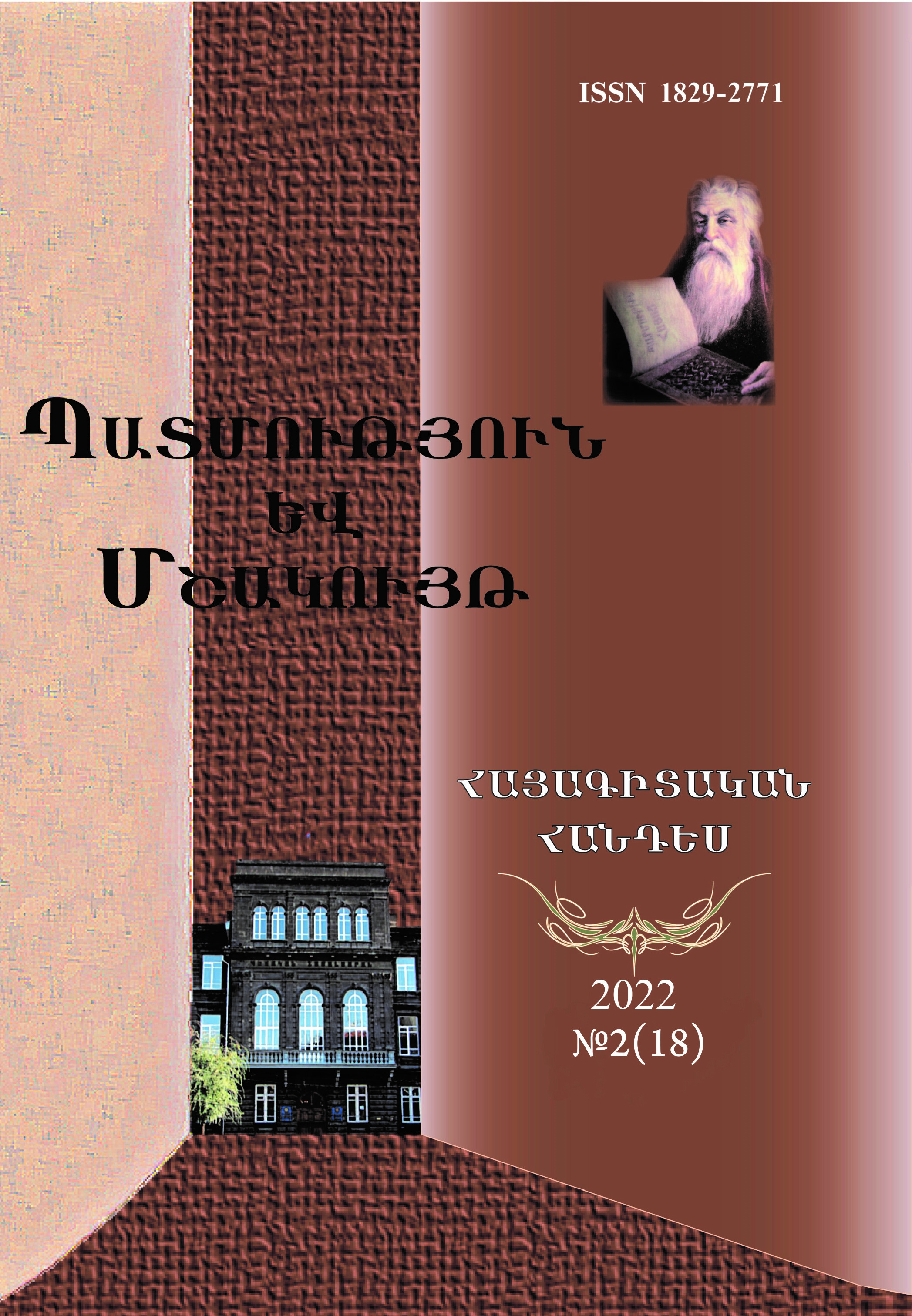The use of Copper Trays Inhausehold in Armenia XIX -XX Centuries
DOI:
https://doi.org/10.46991/hc.2022.18.2.125Keywords:
copper tray, meal, tradition, table, traditional way of life, floral pattern, inscription, folk beliefs, the Ethnographic Museum of ArmeniaAbstract
Summarizing the topic and our research, on the tray, it should be noted that the trays are considered as unique examples of the Armenian culture both from an aesthetic point of view and from that of view of functional significance in everyday life.
In addition to the meaning of their daily use, the phenomenon of their ritualism, which was especially characteristic of the traditional life, is very interesting.
The rich ornament adorning the trays had a peculiar symbolic meaning and a meaning of the amulet.
As for the cultural and everyday value of the trays, which was directly related to the cultural characteristics of the given historical and ethnographic region, we can say that in each period it had different manifestations, the least studied of which is the custom of giving a tray as a gift. So i think it needs a particular research.
References
Abrahamyan V. (1956), Arhestnerě Hayastanum IV-XVIII, Erewan, hrat. Haykakan SSṚ GA: (in Armenian)
Abrahamyan V. (1975), XV dari mi ezaki skutegh, Ashkhatut‘yunner Hayastani petakan patmakan t‘angarani VI, Erewan, «Hayastan» hrat.,ēj17-31: (in Armenian)
Achaṛyan H. (1946), Hayots‘ andznanunneri baṛaran, h. 3, Erewan, EPH hrat.: (in Armenian)
Aghayan Ē. (1976), Ardi hayereni bats‘atrakan baṛaran, h. 2, Erewan, «Hayastan» hrat.: (in Armenian)
Aṛak‘elyan B. (1958), K‘aghak‘nerě ew arhestnerě Hayastanum IX-XIII dd., Erewan, Haykakan SSṚ GA hrat.: (in Armenian)
Bdoyan V. (1974), Hay azgagrut‘yun, Erewan, Hayastani hamalsarani hrat.: (in Armenian)
Bdoyan V. (2014), Javakhk‘i hayots‘ azgagrut‘yuně ew zh’oghovrdakan banarvestě, Erewan, EPH hrat.: (in Armenian)
Davt‘yan S. (1966), Haykakan zh’anyak, Erewan, Haykakan SSṚ GAA hrat.: (in Armenian)
Gyozalyan G. (2001), Musa leṛan azgagrut‘yuně, Erewan, «Gitut‘yun» hrat.: (in Armenian)
Hakobyan N. (1981), Mijnadaryan Hayastani gegharvestakan metaghě IX-XIII dd., Erewan, Haykakan SSH GA hrat.: (in Armenian)
Hovhannisyan L. (2000), Kents‘aghayin ireri imastayin khmbi baṛerě grabarum, «Banber Erewani hamalsarani» 3(102), Erewan, EPH hrat., ēj 77-83: (in Armenian)
Maрutjan A. (1989), Intjeр’jeр aрmjanskogo naрodnogo zhilish’a (vtoрaja polavina XIX- nachalo XX v.), JEрjevan, Izdatjel’stvo AN Aрmjanskoj SSР. (in Russian)
Maрutjan A. (2012), Posjeljenija i zhilish’a, AРMJANJE, Moskva, рjed. Moskva nauka, stр. 205-233. (in Russian)
Mnats‘akanyan A. (1955), Haykakan zardarvest, Erewan, Haykakan SSṚ GA hrat.: (in Armenian)
Nahapetyan Ṛ. (2004), Aghdznik‘ahayeri ěntanik‘ě ew ěntanekan tsisakargě, Erewan, EPH tparan: (in Armenian)
Ōrmanyan M. (1992), TSisakan baṛaran, Erewan, «Hayastan» hrat.: (in Armenian)
Petoyan V. (2014), Sasuni azgagrut‘yuně, Erewan, «Lusakn» hrat.: (in Armenian)
Poghosyan S. (2004), Meghru avandakan tarazi tonatsisakan hamalirě, Hay zh’oghovrdakan mshakuyt‘ 12, Erewan, «Mughni» hrat., ēj 98-122: (in Armenian)
Suk‘iasyan A. (1967), Hayots‘ lezvi homanishneri baṛaran, Erewan, Haykakan SSH GA hrat.: (in Armenian)
Downloads
Published
Issue
Section
License
Copyright (c) 2022 Mery Avetisyan

This work is licensed under a Creative Commons Attribution-NonCommercial-ShareAlike 4.0 International License.

